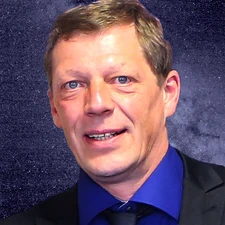Volker Bothmer

The 2021 Julius Bartels Medal is awarded to Volker Bothmer for his outstanding work on understanding the complex nature of coronal mass ejections.
Volker Bothmer is a dedicated research scientist in all that the word entails and has spent decades contributing to our understanding of the underlying physics of coronal mass ejections (CMEs) starting with the analysis of plasma and magnetic field data from the Helios mission. Later, as part of the Ulysses team at ESTEC, he explored for the first time the solar wind structure and energetic particle fluxes out of the ecliptic plane. He has also spent time at the University of Kiel as a SoHO/EPHIN project scientist. Since 2012, Bothmer has been head of the research group on Sun, heliosphere and space weather at the Institute for Astrophysics at the University of Göttingen.
Bothmer’s work on unravelling the 3D structure of CMEs, the related implications of the CME flux rope nature, and connecting them to the insitu plasma and field measurements close to Earth, is recognized by the scientific community. Defining the structure of the CME was critical and groundbreaking because it tied the solar wind structure to the coronal structure and has thus been essential in future works. His very important 1998 study, entitled “The structure and origin of magnetic clouds in the solar wind” that was co-authored by R. Schwenn, should be highlighted in this context. Another important contribution to this field was the analysis that he later performed with Hebe Cremades in relating the structure and orientation of the CMEs observed with LASCO to underlying UV and magnetic field structures. In 2019 Bothmer was third author on the Nature paper “Near-Sun observations of an F-corona decrease and K-corona fine structure” and a co-author on the 1995 Science paper “Cosmic Ray and Solar Particle Investigations Over the South Polar Regions of the Sun”.
Bothmer has an impressive list of publications and was the main editor of one of the first books about applied space science: “Space Weather – Physics and Effects”. In addition, he has participated in many national and international space weather-related projects; for example, as project coordinator, he successfully managed the EU FP7 AFFECTS (Advanced Forecast For Ensuring Communications Through Space) project. Bothmer is very engaged in working with the next generation of scientists, as well as building and collaborating with international groups. In addition to basic research, he has contributed to the successful development of unique and innovative solar missions (STEREO, Parker Solar Probe, and Solar Orbiter) and provided scientific and hardware contributions to several instruments. Furthermore, he is very active in education and public outreach activities on a national and international level.
In summary, the international reputation of Bothmer spans basic research, applied science, project management, contributions to scientific missions and instrument design, as well as education and public outreach activities. The influence of his work on a wide range of topics is highly acknowledged by the scientific community as is seen by his involvement in numerous international projects, serving on a number of diverse panels, and receipt of several awards. Furthermore, Bothmer is a well-known figure at the yearly EGU meeting and has contributed immensely to the EGU Solar-Terrestrial Sciences Division for many years as a science officer for solar physics, presenter (oral and poster), and session (co-)convener. Bothmer’s many accomplishments throughout his career and determination to pursue his scientific interests is an inspiration to us all.
